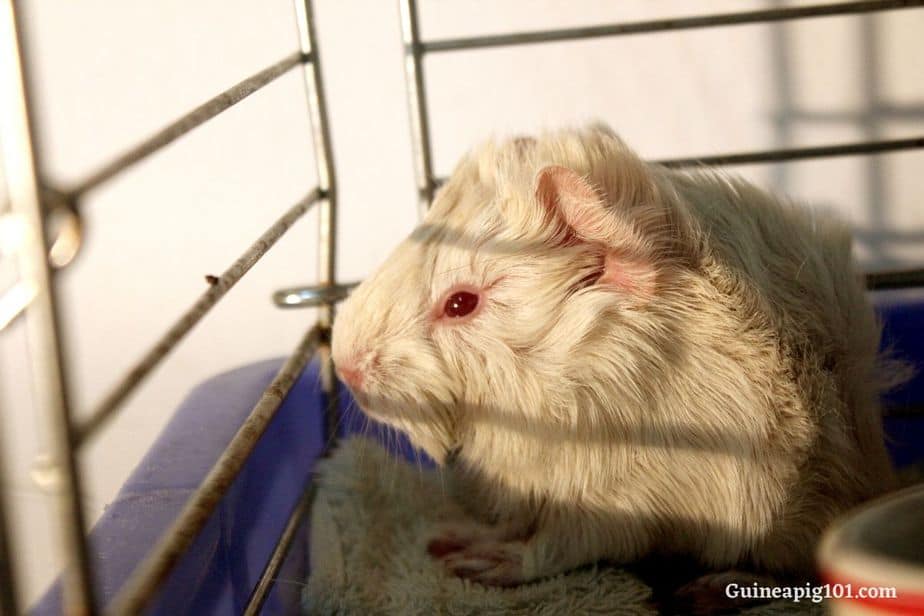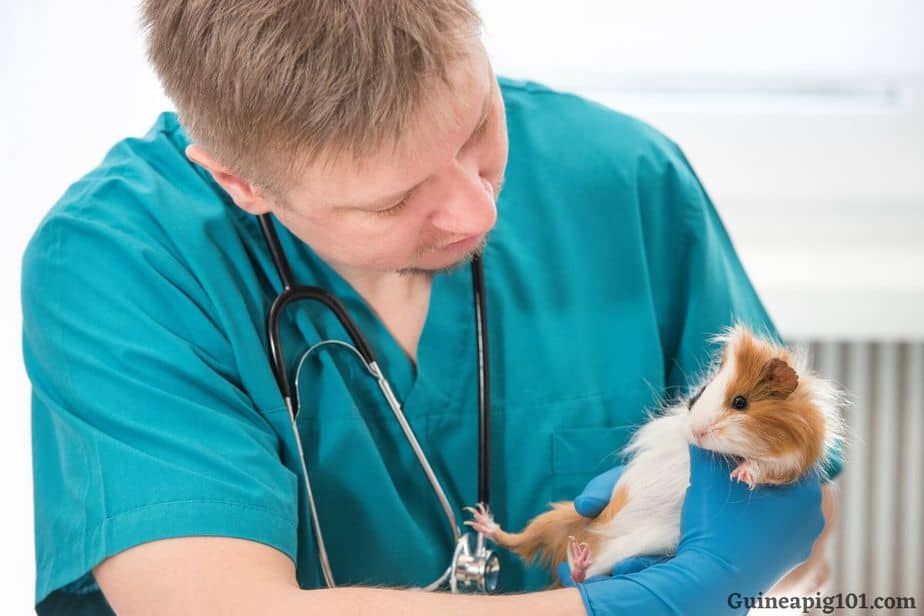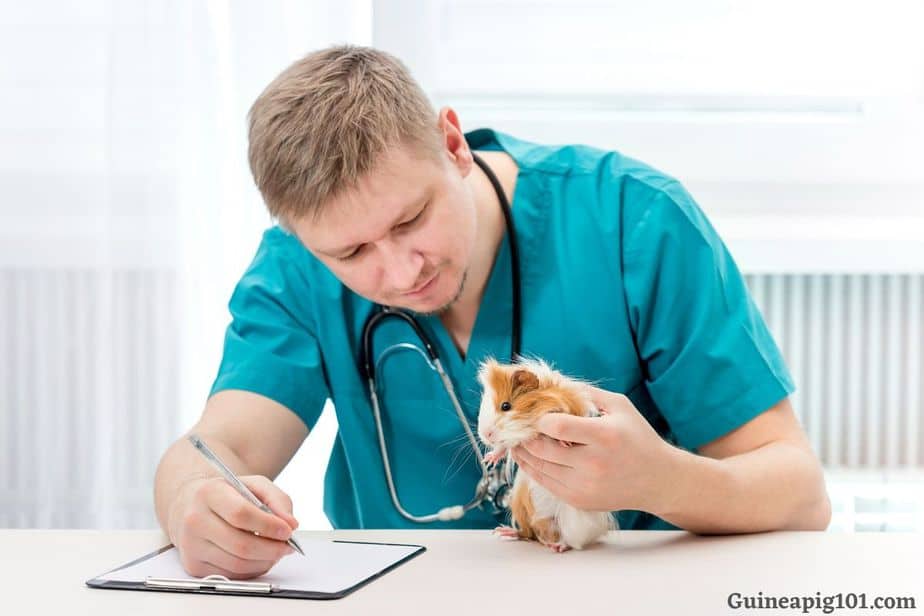Head tilt in guinea pigs should be taken very seriously, and immediate steps need to be taken. Head tilt can be very painful as well as limiting. Struggling from head tilt will make it hard for guinea pigs to drink and eat.
Head tilt can be life-threatening for a guinea pig. Your guinea pig can get their good health back if this issue is treated early, and proper aftercare is provided. Ear infections and parasites are the most common reason for head tilt in the guinea pig.
The most critical part of the recovery process is aftercare. Proper aftercare will help your guinea pig get a functional recovery and prevent the spreading of disease.
Guinea pig owners must be aware of the signs, causes, and treatment of head tilt in a guinea pig. So, in this article, we shall learn all about it. Let’s get right into it.
Is head tilt fatal in guinea pigs?
Head tilt in guinea pigs is not always a critical issue. According to some vet, we are too quick to lose hope if a guinea pig had a head tilt.
Despite that, It is a very critical condition. Your guinea pig can have the best chance of survival if:
- If it is detected early: As it can turn to severe disease in a further stage. Sooner it gets discovered sooner your guinea pig will be healthy again.
- If guinea pigs usually function: Guinea pig has the best chance of survival if they are still able to eat, drink, and groom themselves.
- If a guinea pig is still breathing through its nose: Guinea pigs breathe through their nose, and if they are still breathing through their nose, then it is a good sign. But in case they breathe through their mouth in a condition of head tilt, then it is a medical emergency.
If the head tilt is severe and your guinea pig is going through enormous pain, it is sometimes best to let them go.
What is head tilt in guinea pigs?
Torticollis is the clinical term for head tilt, also known as wry neck. There are cases in which your guinea pig head tilts to the side or tilt upwards.
Torticollis can be lenient, modest, or severe. Some guinea pigs have a very inconsiderable head tilt, while others have a distorted neck.
Guinea pigs with torticollis face difficulties in being in remaining calm, and also they feel troubled or nervous. Pain is the reason for this. Not being able to keep their head upright will result in having trouble eating and drinking.
If your guinea pig lives normally even after having a head tilt, they will still need to be seen by a vet as head tilt can be a critical condition in a later stage.
Why do guinea pigs tilt their head
There can be various reasons for a guinea pig head tilt.
There can be cardiovascular disease, bacterial infections, or parasite infections.
Your guinea pig can also go through trauma, tumor, or muscle spasms.
These all can be a reason for head tilt in your guinea pig. We will talk about all these issues in detail further.
What causes head tilt in guinea pigs?

Head tilt is the disease which can be caused by many different factors, of which some of the most common factors are:
- Trauma: Head injury is not a significant reason for head tilt, but it is something you should be aware of.
- Tumor: In some of the cases, tumors in the ear, neck, or brain can be the reason for the head tilt.
- Muscle Spasms: The reason for this can be temporary stress, excitement, or other causes, Though muscle spasms too are temporary.
- Cardiovascular Disease: Guinea pig having heart disease may fling their head backward for taking in more air. Stroke can also be the reason for head tilt.
- Parasite Infections: Encephalitozoonosis is a hazardous parasitic infection that can cause a head tilt in guinea pigs.
- Bacterial Infections: Origin of such diseases are nose or windpipe. Moving such infection into the inner ear can result in causing head tilt.
Some of the causes are much more similar than others, so let’s dive deeper to explore the common causes of head tilt.
Encephalitozoonosis and Head Tilt
Encephalitozoonosis is the most common reason for head tilt. It is caused by the encephalitozoon cuniculi parasite.
This parasite conquers the cells of a guinea pig. The cells in the eyes, kidney, and central nervous system are most affected.
It takes weeks or sometimes even months for the head to tilt when your guinea pig gets infected with encephalitozoonosis.
The very first signs of this infection are as follows:
- Dragging of the feet
- Stumbling
- Swaying
If your guinea pig has become clumsy up to an increasing extent, maybe a parasite has taken hold then.
Why early treatment is crucial
Early treatment is essential to prevent the head tilt from a critical condition.
Also, head tilt is not only the reason for the initial treatment, as encephalitozoonosis can lead to:
- Heart disease
- Eye disease
- Kidney disease
- Lung disease is rare, but it can lead to pneumonia.
How do guinea pigs get E. Cuniculi
This tiny parasite can be detected in the pee and poop of the other animal.
Guinea pigs can get infected if they touch or even breathe in these spores. Following risk factors are:
- A guinea pig can get infected in case they are living with the other guinea pig who is affected by encephalitozoon cuniculi parasite.
- Cramped living conditions.
- Living in a dirty and unsanitary condition.
- Breeding with various other guinea pigs.
- Guinea pig is having contact with a wild animal.
- If a guinea pig is having E. cuniculi, anything which can weaken the immunity of a guinea pig can tremendously heighten it.
Sometimes the symptoms of a parasite are not detected for over a year. So whenever you buy a guinea pig, make sure to get your guinea pig through a screening test for E. cuniculi.
This disease can also pass from a mother to a child during the birth process.
Other parasitic infection in guinea pigs

Cuniculi is one of the most well-known exploitative diseases, but there are others and you need to be aware of it. These four parasites can be obtained from pets, wild creatures, and insects.
Cuterebra
Cuterebriasis is a kind of parasitic infection that can trouble the guinea pigs as it can lead to severe head tilt and life-threatening conditions. Cuterebra is actually a species of flies.
These flies come down on the guinea pig’s fur and produce eggs in their skin. That will lead to an imbalance in the system, wryneck, and other illnesses as the eggs enter the guinea pig’s inner nervous system.
Toxoplasma Gondii Infection
This disease can harm your guinea pig from time to time. Cats are most often induced by Toxoplasma gondii.
If you have cat and guinea pig in your house then the chances of your guinea pig getting infected go up significantly.
The guinea pigs can get these bacteria from the urine and the wastes of cats.
Head tilt and imbalance is caused by Toxoplasma gondii infection. It can even also grow to human beings in a few cases.
Ear Mites
Another bacteria that can create head tilt is ear mites.
The symptoms of ear mites include unnecessary scratching, grunting, and head trembling.
Baylisascaris spp
That is a kind of roundworm that lives in the guts of raccoons and skunks.
If guinea pigs are permitted to eat grass outside, then they could contact this bacteria. Also, several varieties of bedding might be infected with Baylisascaris spp.
When the eggs enter the guinea pigs’ inner nervous system, they will begin to eat away the brain tissue.
In the short term, Head tilt can be caused by this. Once this enters the brain tissue, this bacteria will almost inevitably cause a life-threatening condition, so quick treatment is necessary.
Bacterial infection and guinea pigs head tilt

Another infection that can cause a twisted neck is a bacterial infection.
This kind of bacterial infection mostly starts in the guinea pig’s nose or throat. It gets difficult for your guinea pig to breathe correctly due to this bacterial infection.
So, your guinea pigs will usually cock their head sideways or upwards to breathe properly.
That may create a little head tilt if bacterial infections are carried inside the nose or throat (and do not even move to the middle ears).
Some further symptoms are:
- Coughing, sneezing, and puffing
- Slow or fast breathing
- unclear or cloudy release from the eyes and nose
- decreased in hunger
- Laziness
- Swelling of the noses
The bacterial infection will move from the nasal passage into inner ears if left unchecked.
Guinea pig ear infection head tilt
One of the most typical problems of head tilt is an inner ear infection. This infection begins to start in the nose first and then move to the internal ears.
At the same time, when the infection enters the inner ears, the head tilt will be extremely noticeable.
In most of the cases, guinea pigs refuse to eat food and drink the water due to this infection. That will lead to a quick weight loss and gastrointestinal stasis, so it is a medicinal emergency.
The most well-known example is Pasteurella multocida, there are many other types of bacteria that could cause guinea pig ear infection.
These include Pseudomonas aeruginosa, Staphylococcus sp, and Bordetella Bronchiseptica.
Muscle Spasms and Head Tilt
Muscle spasms are very tricky because, in many cases, this could be a sign of infection. But, sometimes they are not the symptom of any sickness.
If you overstimulate your guinea pig, they will occasionally spasm. These occasional muscle spasms can lead to temporary head tilt in guinea pigs.
It is possibly not a cause for attention if your guinea pig’s head tilts just for a minute or two.
If your guinea pig’s head tilt happens repeatedly, or for an extended time, then this should be examined.
Heart disease and guinea pig head tilt
Guinea pigs who have heart disease usually bend their head back. Maybe this is because guinea pigs are struggling to breathe, and perhaps this state gives relief to them.
It is hard to have differentiated between heart disease and parasitic infections, as they both are similar.
As an example, the conditions of both heart disease and parasitic infection can cause difficulty in breathing, loss of taste, and head tilt.
Possibly one remarkable exception is that guinea pigs who have heart disease have swelled eyes.
Also, the parasitic infection can extend into heart disease if it will be not handled on time. Encephalitozoonosis can expand into consequent heart disease as well.
Stroke and guinea pig head tilt
Head tilt in guinea pig can also be caused because of another cardiovascular disease called a stroke.
As it is infrequent in guinea pigs, but you should be aware of symptoms.
Symptoms of stroke in guinea pigs are:
- Circling
- Tremors
- Paralysis in the hind legs.
- Facial weakness
- Side to side-eye movements
Stroke has apparent symptoms, and it can’t be confused with other conditions.
Trauma and wry neck
Head trauma leads to a wry neck. Guinea pigs get collisions to the head for all kinds of reasons.
For example, If your guinea pig is suddenly stunned by other animals, they may hit their head accidentally by running away.
Guinea pigs are flighty, so all these accidents are common in guinea pigs.
In case of a severe injury, pain killers are prescribed to guinea pigs so they can eat, walk, and groom themselves.
Tumors and head tilt
Tumor in the neck, face, or back can be the reason for head tilt in your guinea pig. The tumor is caused by unusual growth of tissue, whether it is benign or malignant.
The lump may hold water, fat, blood, or cancer. If your guinea pig has a tumor, then it’s unlikely to be cancerous. Cancer in the guinea pig is a rare scenario.
Benign tumors should be examined adequately as they can lead to a very painful head tilt.
Is head tilt in guinea pig contagious?
There is a risk for other guinea pig’s health as well if your guinea pig has a bacterial or parasitic infection. It is usually contagious to dogs, cats, and other animals also.
Some of the examples are, Bordetella bronchiseptica is contagious on dogs and cats, and toxoplasma gondii is contagious to cats. Some of the infections can even get transferred to humans.
Treating head tilt in guinea pigs

Your guinea pig will be provided the following treatment by your vet after running some tests. These treatments include:
- Fluid therapy: The fluid injection will be needed in case your guinea pig shows a struggle in drinking.
- Physical therapy: Gentle back and neck massage can be helpful for your guinea pig with a wry neck. Make sure you don’t try it at home as it’s a professional work and should be done by a professional.
- Nutritional therapy: If your guinea pig is not able to eat and drink properly, then the syringe will be helpful to feed until they get their strength back.
- Surgery: Surgery may be needed in only some rare cases.
- Pain Medication: Various types of painkillers and anti-inflammatories are there. Corticosteroids can be useful if they are used in small quantities. But, it can make things worse if taken in for too long.
- Head tilt medication: Many infections are treated with antibiotics. For example, Tetracyclines are used to treat for e. cuniculi. Different types of medicines are prescribed by the vet in case your guinea pig is suffering from cardiovascular illness.
Aftercare for guinea pig with head tilt
During a recovery period, your vet will let you know how to take care of your guinea pig.
You must follow your vet suggestions as it will meet the requirement of your guinea pig.
Some of the advice of your guinea pig aftercare are as follows:
- Food and drink: Guinea pigs will have to eat and drink to prevent themselves from gastrointestinal stasis.
- You should feed them something tasty like herbs or leafy greens.
- You have to feed your guinea pig through a syringe if they cannot eat.
- Cleanliness: Your guinea pig suffering from such an issue will find it hard to clean themselves. Help your guinea pig by grooming them and wiping them with a damp cloth, as they will need your help.
- Take the use of a microfiber towel for drying them to make sure they don’t get cold.
- Also, make use of warm water and cotton wool for cleaning their eyes.
- Warmth: Guinea pigs need to stay warm when they are healing from an injury or illness. Get your guinea pig inside if they live outdoors until they get completely recovered.
Preventing head tilt in guinea pigs
Head tilt is a hazardous and critical condition. So, we must do our best to prevent it in the first place.
Some tips to prevent head tilt in guinea pigs are:
- Whenever you adopt a new guinea pig, make sure to have them screened for e. cuniculi.
- Make sure you arrange an enclosure big enough for the number of guinea pigs you have.
- Regularly clean your guinea pig enclosure to prevent infections.
- You should check your guinea pig fur regularly, to make sure that if there are any signs of urine scald and flystrike.
- Make sure that your guinea pig is not getting in contact with the wild animals.
- Ensure that other household pets like dogs and cats don’t come regularly in connection with your guinea pig.
- If you have any other household pets like cats, make sure that you usually provide flea treatment.
- Clean your cat poop immediately and disinfect the areas that have been infected with the cat urine or feces.
- Check your guinea pig regularly to know that if your pet is having any signs of illness.
Many of these diseases take time to cause head tilt.
In the beginning, it produces light symptoms such as rapid breathing, swaying, and tripping.
Detecting such illness in an early stage will create the best chance of survival for your guinea pig.
Source: Ear Infections in Guinea Pigs, Paradoxical Vestibular Syndrome Secondary to Temporal Bone Osteomyelitis and Chronic Otitis Interna in a Guinea Pig, chondroblastic osteosarcoma of the middle ear in a guinea pig, Case report of a guinea pig, Inflammation of the Nose and Sinuses
